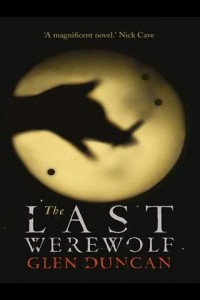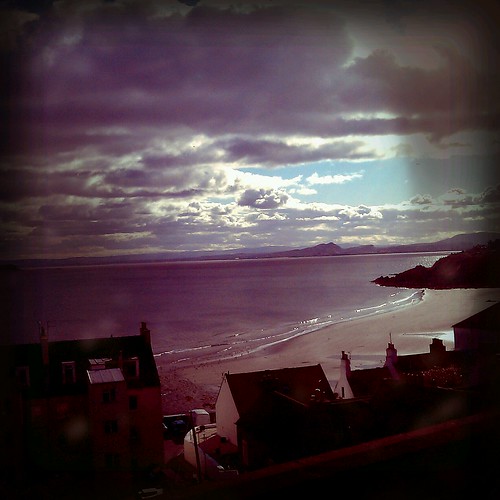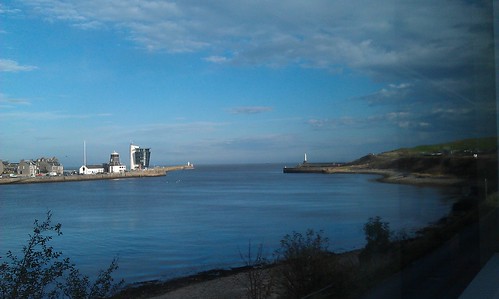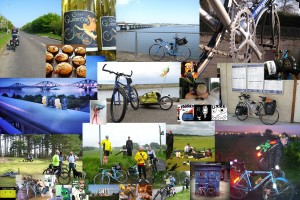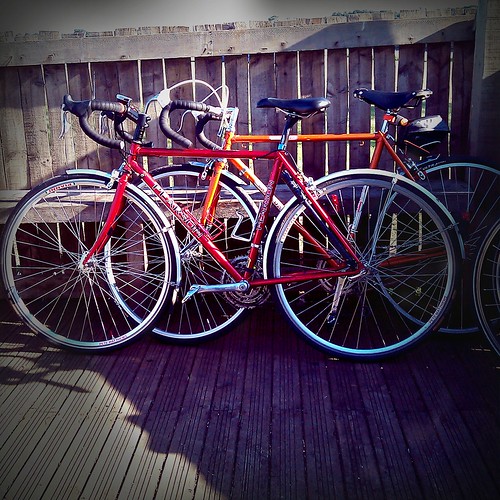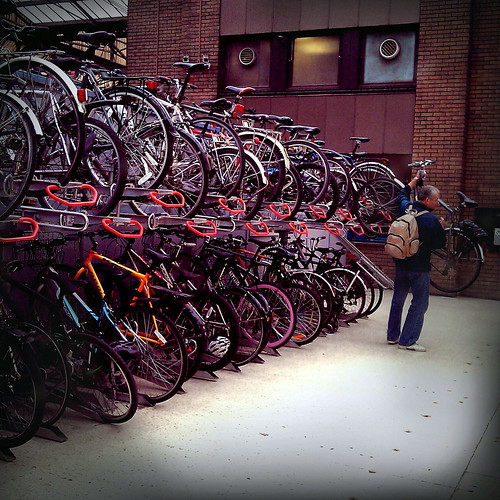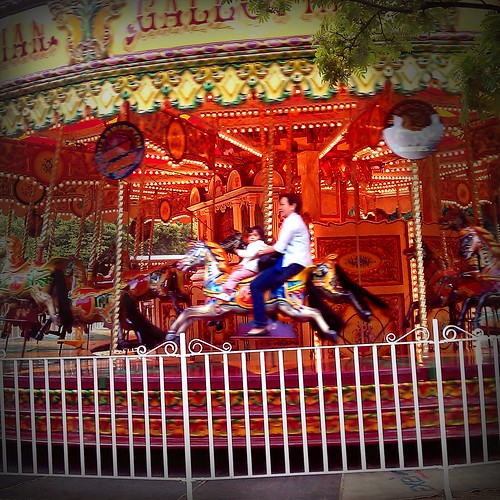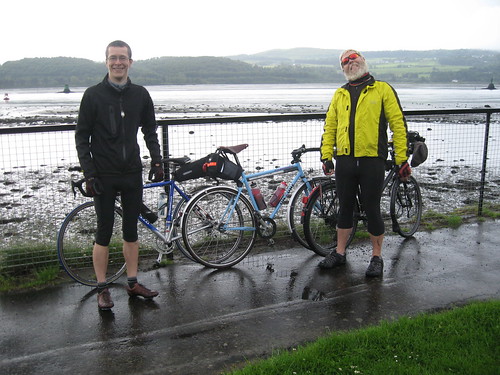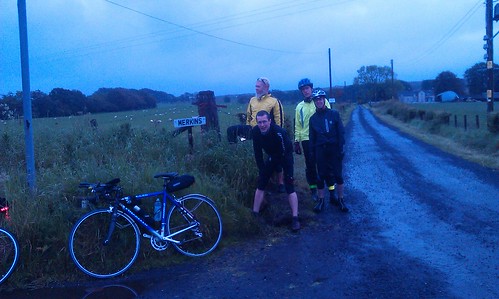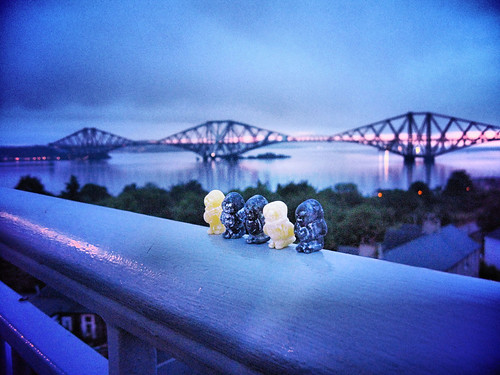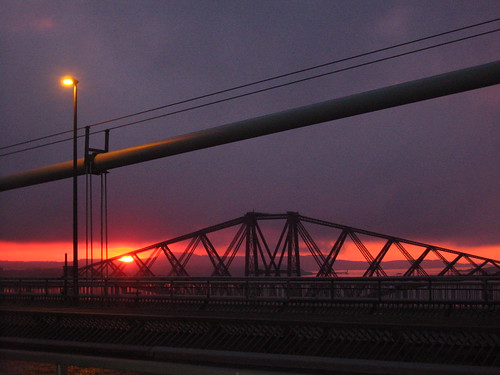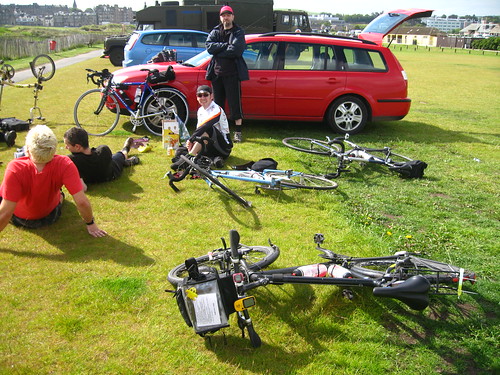Sam reviews: The Last Werewolf
Nov.05, 2011, filed under books
![]() It was with a mix of sympathy and amusement that I read this article on iO9 responding to Glen Duncan’s piece on Colson Whitehead’s Zone One in the New York Times magazine. On the one hand we have the opening paragraph, which is clearly a rather unwarranted set of clichés and prejudicial presumptions:
It was with a mix of sympathy and amusement that I read this article on iO9 responding to Glen Duncan’s piece on Colson Whitehead’s Zone One in the New York Times magazine. On the one hand we have the opening paragraph, which is clearly a rather unwarranted set of clichés and prejudicial presumptions:
A literary novelist writing a genre novel is like an intellectual dating a porn star. It invites forgivable prurience: What is that relationship like? Granted the intellectual’s hit hanky-panky pay dirt, but what’s in it for the porn star? Conversation? Ideas? Deconstruction?
On the other we have the undeniable fact that Duncan clearly likes the work in question:
There will be grumbling from self-¬appointed aficionados of the undead (Sir, I think the author will find that zombies actually…) and we’ll have to listen for another season or two to critics batting around the notion that genre-slumming is a recent trend, but none of that will hurt “Zone One,†which is a cool, thoughtful and, for all its ludic violence, strangely tender novel, a celebration of modernity and a pre-emptive wake for its demise. If this is the intellectual and the porn star, they look pretty good together. For my money, they have a long and happy life ahead of them.
As it happens, Duncan’s The Last Werewolf has just moved off the top of my currently reading pile, and while I do have issues with Duncan’s blunt stereotyping of both intellectuals and porn stars, I think the only work he’s hurting is his own.
There is little chance of anyone trying to argue that The Last Werewolf is not a piece of genre fiction — and, before anyone starts screaming blue bloody murder, I do not think that this is a bad thing. Personally I get fed up with the insistence on labelling and hierarchies just as I get fed up with people who complain that action movies are somehow inferior simply because they tick all the boxes in the correct order. A book isn’t necessarily bad if it has as its primary goal the attempt to entertain. Not every single piece of written word has to have as its underlying purpose the statement of something profound about the human condition.
Nor is this to say that genre fiction can’t have something profound to say about the human condition. Genre fiction has a great deal to say about the human condition, and can be as thought-provoking as any so-called literary work.
Indeed, The Last Werewolf reads not so much as a depiction of lycanthropic existence as an attempt to pen a study of graceless ennui caused by over-stimulation, perhaps as an allegory for the internet generation’s desensitised state of been there, done that, got the two-girls-one-cup-happy-slap-t-shirt.
It did not light any fires chez Raven. It was a decent book — I have no showstopper complaints about it. I read it right through to the end and didn’t have to stop to rant (much) at any point. The prose was well-constructed, the imagery suitably lyrical, and the writing style avoided being clunky at any point. Marlowe’s character had a very definite voice, which meant the first-person perspective worked well. The idea that werewolves in this world were not eating the flesh of their victims so much as their histories and memories was a great one: taking a life meant taking a life, leaving one to infer that a werewolf’s lifespan was limited by sheer capacity more than biology. I enjoyed the throwaway trivia, for example that the expected pack structure was not there because female werewolves were in such short supply any other male would be regarded as a sexual rival. While I don’t want to give any plot spoilers, I appreciated that the female characters were, in their own way, powerful, and in some cases more powerful than gender stereotyping might lead one to expect.
Yet there were too many clichés spoiling the originality. Surely we have had enough of the vampire hates werewolf, werewolf hates vampire trope? Duncan went to some lengths to explain it but I sighed when Pratchett did it and Duncan does not have a pre-loaded soft spot in my heart as Sir Terry does.
I had issues with the pacing. The first two thirds of the book read like one of those movies in which there is lots going on but, inexplicably, nothing actually seems to be happening. This was no doubt meant to reflect Marlowe’s loss of enthusiasm for life, however it left me feeling oddly unmoved by any of the dramatic scenes, which meant that they were rendered not all that dramatic. Not enough was made of Marlowe’s access to the memories of those he had consumed and there were moments when I was left thinking “show, don’t tell”. At one point, in the last third of the book, there was an example of this so egregious I found myself thinking “FFS, couldn’t you at least try?”
Once again we had the assumption that living a long time means being able to accumulate vast riches. I suppose we wouldn’t have had all the globe-trotting if he’d been a pauper rather than someone for whom a cool twenty million is mere pocket change and I suppose one could argue that 200 odd years is enough time to get rich. Marlowe started off rich, though, which was irritating. I feel that there should be only so much disconnect between the reader and the protagonist, and there are big enough hurdles in getting to grips with the idea of being obliged to consume a person and his entire living memory once a month, as well as the idea of being so full of other lives and bored with one’s own life (not unhappy with it, but bored) that a violent death seems the preferable option without having to imagine being financially carefree in a way that only a tiny fraction of a percent of the world’s population experience.
You see, there was something that came close to being a deal breaker: Marlowe as a werewolf was the hybrid, bipedal, intelligent man-wolf type, nine feet tall and apparently unconstrained by conservation of mass.
I read advice somewhere to the effect that the reader will suspend disbelief for one thing and one thing only, so the writer would do well to make sure that one thing is the most implausible part of his story and that his plot hinges on it. Unfortunately for my enjoyment of this book the most implausible part of the story was that an ordinary-sized man can turn into a bipedal wolf-creature that is nine feet tall and stronger than Marius Pudzianowski. I let that slide, but then found myself unable to stop grousing about other major implausibilities.
Duncan’s review of Zone One left me wondering whether he thought it was the porn star or the intellectual who was aiming below his or her station in life. It is easy to infer he was describing a form of superiority when he wrote:
“…he’s a literary writer, hard-wired or self-schooled to avoid the clichéd, the formulaic, the rote.
Given that Duncan’s own work is a literary kind of genre fiction, taking this analogy at face value leads inevitably to one question: Does Duncan see himself as the porn star or the intellectual?
Because, quite frankly, in The Last Werewolf he has produced something that, while being entertaining and by no means the worst werewolf book I’ve ever read, fails either to deliver on the porn-star’s delight in his material or the intellectual’s hard-wired avoidance of rote and cliché.
If you want a good book about werewolves that examines the human condition, I recommend Kit Whitfield’s Bareback.
A room with a view
Nov.01, 2011, filed under Life with Frood, Photography
![]() It has been a month of big changes. When we moved to Scotland — a return to home territory for me but a new country of residence for Frood— we initially lived in Fife. I was born and mostly raised in Fife (even if my most potent childhood memories are all of the west coast, Highlands and Islands), so the territory was one with which I was gratefully familiar. It’s hard enough making a change of job that significant without having to learn a new geography as well, at least when the job requires a good local knowledge.
It has been a month of big changes. When we moved to Scotland — a return to home territory for me but a new country of residence for Frood— we initially lived in Fife. I was born and mostly raised in Fife (even if my most potent childhood memories are all of the west coast, Highlands and Islands), so the territory was one with which I was gratefully familiar. It’s hard enough making a change of job that significant without having to learn a new geography as well, at least when the job requires a good local knowledge.
After a year or so I transferred to Edinburgh, as Frood was working there and was tired of the lengthy commute and the seasonal rail fares taking up a significant chunk of his monthly pay. We’ve been living and working in and around Edinburgh for four years, which is by no means the least time I’ve spent in any one place, although it’s towards the bottom of the scale.
 I am restless by nature, easily bored and always looking for the next intellectual challenge. I doubt I will ever be satisfied with going in to work to do the same thing day after day. My comfort zone is not static. It’s more of a bouncy castle, floating in a swimming pool on the deck of an ocean liner in the middle of a storm.
I am restless by nature, easily bored and always looking for the next intellectual challenge. I doubt I will ever be satisfied with going in to work to do the same thing day after day. My comfort zone is not static. It’s more of a bouncy castle, floating in a swimming pool on the deck of an ocean liner in the middle of a storm.
Fortunately, just as my feet were growing itchy again, the desire to get back to dealing with the technical specialisms of water pricking at their otherwise insensitive soles, an opportunity came along.
This month we’re in the process of upping sticks and moving to where granite rock glistens in the salt spray of the North Sea and radon seeps from the ground in quantities insufficient to have any significant health implications, never mind be enough to activate the Marveliser (dammit). Here the local tongue is the Doric and I will be as linguistically handicapped as Frood, for my knowledge of the Doric starts and ends with poorly-remembered episodes of Scotland the What? from an old audio cassette we used to have.
I have managed to get lost three times in the last week, a decent sense of direction apparently being insufficient when there is a complete lack of familiar place names and/or landmarks. I am learning that it gets dark damnably early, especially since the clocks went back, and that the warnings about it being cold did not take into account the preferences of a cryophiliac like me. My ride to work in the mornings is short enough that I arrive before I’ve really got going. The supermarkets have the same names above the entrance and yet their selection of goods is both entirely expected and unfamiliar: along with the dubious pre-packed pizzas and DVDs for £3 I can buy daikon radish at the Morrison’s on King Street —an item of exotica never seen in Granton’s Waterfront Broadway store— and, wondrous wonder, CR2032 batteries, yet I cannot buy gluten-free plain flour there. The Sainsbury’s in Berryden, in addition to the usual range of chocolate and teabags, sells special handles for poach pods but doesn’t have any Spanish smoked paprika or Clearspring white miso.
Cultural and consumable differences aside, what has struck me the most is something both more and less mundane:
That’s the view from my office window. This is my lunchtime run route.
I think I’m going to like it here. I hope Frood will, too.
Now I just need to find somewhere selling Celestial Seasonings Apple and Cinnamon Spice tea.
Wet wet wet
Oct.02, 2011, filed under Writing
![]() I returned from our soggy, windswept, noisy trip to Wester Ross to a couple of pieces of very good news. Firstly the contract for my new job arrived, so the reality of our impending move to the North-East has finally started to sink in. I’ve now got to start planning what is going to be a fairly hectic couple of weeks as we get everything sorted out for the move, and there is bound to be some toing-and-froing, which won’t be much fun as it’s a 3 hour drive, but has to be done.
I returned from our soggy, windswept, noisy trip to Wester Ross to a couple of pieces of very good news. Firstly the contract for my new job arrived, so the reality of our impending move to the North-East has finally started to sink in. I’ve now got to start planning what is going to be a fairly hectic couple of weeks as we get everything sorted out for the move, and there is bound to be some toing-and-froing, which won’t be much fun as it’s a 3 hour drive, but has to be done.
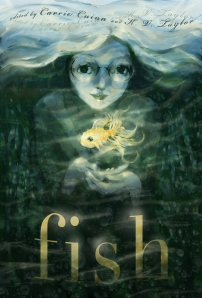 Secondly I received notification that my story What the Water Gave Her has been accepted by Dagan Books for their upcoming Fish anthology. I’m very pleased and excited to have work included alongside that of such talented writers, and thanks to Carrie Cuinn and the team at Dagan for choosing my piece. The cover art, by Galen Dara, is beautiful, with a gorgeous dreaminess that was a big part of what inspired me into a feverish flurry of writing (thank you flexi-time).
Secondly I received notification that my story What the Water Gave Her has been accepted by Dagan Books for their upcoming Fish anthology. I’m very pleased and excited to have work included alongside that of such talented writers, and thanks to Carrie Cuinn and the team at Dagan for choosing my piece. The cover art, by Galen Dara, is beautiful, with a gorgeous dreaminess that was a big part of what inspired me into a feverish flurry of writing (thank you flexi-time).
Now Frood and I are off to the Museum, because we’ve only got three weeks to look at all the things in Edinburgh we’ve been meaning to look at since we moved here four years ago!
Cycling is…
Aug.20, 2011, filed under Cycling
![]() Last week I was asked to participate in a focus group for the CTC, which was something of a surprise — on telling Frood his response was: “What, you? Haven’t they learned anything?”
Last week I was asked to participate in a focus group for the CTC, which was something of a surprise — on telling Frood his response was: “What, you? Haven’t they learned anything?”
I was quite pleased, really, because I’d started giving up hope on the CTC. As far as I’m concerned they’re still pretty much the only organisation out there doing what I want a cycling organisation to do: campaign for the rights of cyclists to carry on doing what we’ve always done, i.e. ride on the road, and campaign proactively for our right to do so without fear of being squished by inattentive car drivers. I used to be a Right to Ride rep, but gave up when they started softening their attitudes towards segregation and falling for the old “some provision is better than nothing” gambit, which in my opinion is the most dangerous trap for a cycling campaigner. The moment someone told me that it was okay for a local authority to fail to maintain road standards suitable for cyclists because there was an off-road, shared-use path, I was out of there.
Then there was the charity kerfuffle. For those who don’t know about this, the CTC didn’t used to be a charity. It was a member’s club, like the AA or BSAC, which made sense to me. I paid them a certain amount of dosh and in return I got certain member benefits, like third party insurance, as well as the comfort of knowing the organisation was out there promoting the interests of me as a cyclist, and of other cyclists out there. Then they decided to become a charity. In my mind this makes them more like Greenpeace — not necessarily a bad thing, but I’m not sure how they square member benefits and their commercial wing with being a charity; and the offered explanations were opaque. Not only were the explanations opaque, the rather impolite way the two sides of the debate went about garnering votes didn’t merely lose my interest, it flung any curiosity or investment I had in the process out of the window then stamped on it repeatedly with boots covered in dog shit. If I hadn’t been absorbed in other matters at renewal time, I’d probably have cancelled the direct debit.
I wasn’t pleased to be asked to participate in this group because I thought it was a recognition of the things I’d said way back when (I doubt that the CTC knows I was one of those asked to participate): I was pleased because it meant that finally they were doing something to make it look like they were paying attention to what their members had to say about them, and about what their members want from them.
There’s a first time for everything after all.
We had to complete some homework before the group, part of which was to create a collage representing what cycling means to us: a collection of pictures depicting our involvement in cycling and the emotions that cycling evokes. What was most interesting about this was how similar the results were. There were four of us in our particular group, all of us members, three men plus myself. Our ages ranged from 24 to 40 and we were pretty diverse in terms of careers and how much cycling we do (although I did note that we all fell fairly neatly into the “white, middle-class” demographic). All of us talked about independence, freedom and sense of achievement, as well as a streak of non-conformity.
Here’s my effort (click for a big one in a new tab):
Cycling is a big part of my life. I had to cherry-pick memories to represent concepts: moments that are the distillation of hours of adventure.
From left to right, top to bottom.
Frood ahead of me on a trip to Lincolnshire. I was sick that day. Horrendously so. I was in the early stages of acute bronchitis and my heart rate was through the roof, hovering at around the 190 mark even at a meagre 15mph because I couldn’t extract enough oxygen from the air. It was like being at altitude. But I did it, Frood sitting ahead of me the whole way so I could draft him (with the added side-benefit of being able to stare at his bottom).
A wine bottle label, for the aesthetic element. Cycling isn’t just about function, it’s about form. There’s nothing more beautiful than something that is not only artfully designed but also does a job, and I’m not just talking about the bike. You can keep your stick-thin models and bodybuilders who are as weak as kittens. I like my women athletic rather than anorexic, and my men strong rather than muscular.
Cake. Blueberry muffins. Need I say more?
Shackleton, on the banks of the Tay. I was riding home from a training course that day, 40-odd miles, just for the hell of it. I do that sometimes. Having a bike means that travelling for business can be fun rather than a chore.
Peregrine, Campag chainset gleaming in the sun. You cannot possibly tell me that this isn’t beautiful. Look at it!
A velvet fist concealed within an armoured glove. This is the other side of cycling: the assertive, occasionally aggressive side. Not everyone likes this part of it, but I kind of do, and I’m not going to pretend it doesn’t exist. I will, however, note that it doesn’t have to. You don’t have to be a superhero to commute to work, but if you like the feeling of being one, well, that option exists. You can ride at a sedate, steady pace and get to work with your hair in place and your work clothes ready to go; or you can put on lycra and a fierce grin and traffic jam like it was sport. Cycling is whatever you want it to be.
Jelly babies on the bridge at dawn during DRV. Cycling can be an adventure, and it can be doing silly things with like-minded people and having experiences you couldn’t have any other way. It’s about seeing things in a way you wouldn’t ever see them from inside a car, and about getting places under your own steam at a pace that can surprise you, often fuelled by little more than sugar, water, and a sense of determination.
Max, with the Bob Yak, and the fish flag, sitting outside our old flat in Kirkcaldy. Think that you can’t carry much on a bike? Think again. I can carry masses of stuff with that sucker. The Bob Yak even features as a hinge for a piece of plot in one of the stories I’m working on (minus the fish flag, I have to say).
Munky, snoozing on a train. The bike is the only means of independent transport you can carry with you on other forms of transport. How awesome is that? This also represents the happy, physical exhaustion that comes about after a decent ride. He’s surrounded by some smaller images representing the occasional sense of outrage and gobsmacked bemusement engendered by other road users.
Fingal, fully loaded at Inverness station. You can carry your home on your bike, if you’re happy to call a tent a home. You can strip your life down to the bare essentials of shelter, food and a means of cooking it, water, the clothes you stand up in and a spare set; and, in my case, a notebook and pen. You can pack all of this on a bike and you can go wherever there is a road or track to take you. Unlike walking, however, on a bike the weight is shifted by a geared mechanism, so you can pack a few non-essentials like fishing gear, snorkelling kit, espresso maker, art materials, beer…
I really like beer.
There’s my mum and dad, talking to someone we met in Tentsmuir Forest. I don’t ride off-road much because I have no 3D, but I really, really love riding fire trails and easy routes with my parents. Cycling is the one activity that they like as much as Frood and I do. Well, that and hillwalking, but mum and I both have issues with old foot injuries that make walking any distance quite hard. Cycling can be a family affair, and it’s something people can enjoy for many years. The lack of jarring impact makes it ideal for those with dodgy joints.
More Dumb Run shots. It’s the adventure thing again, and the achievement, and the ability to find enjoyment in ridiculous conditions. Yes, we will beast ourselves up those hills and dare the midges because there’s Merkins Farm at the top, and that’s funny. It doesn’t matter that it’s 3am and pissing down, we’re already at Linlithgow and it’s not much further to go until the bridge and oh! My bike looks like deep sea plankton! How cool is that?
Some random stuff. A smiley face (a screenshot from Death Machine, as it happens. I’ll leave you to draw your own conclusions). Me, fettling. I can do my own maintenance. I’m wearing very little and yet it’s one of the few photos of me I actually like and in which I think I look okay. Cycling does that for you. Stitch, drooling over the shiny, which is what I do whenever a Campag catalogue arrives in the post.
Tank Girl is more about attitude than anything else. I can’t really explain this one. It’s all about the feeling.
The next picture is the Burton’s factory on my way to work. I am tortured by the smells of biscuits wafting from that place when I ride past. You don’t get sights, sounds and smells in a car the way you do on a bike. I keep thinking I should write to Burton’s and ask them what biscuits they’ve been making that day to see if what my nose tells me they are making is what they are actually making. Because that would rock.
Beer, noms. ‘Nuff said.
More mountain biking with Frood and my parents, and then Fingal sitting outside a police box in Edinburgh. Two forms of transport that are bigger on the inside than you think from the outside and can take you places where you’ll see things you could never have imagined and didn’t expect.
Yes, that is a Doctor Who reference. Just roll with it.
One of the questions in the focus group was about what the CTC should be offering its members: what one thing could they do that would make a difference. Cycling is all of these things, and more. It’s adventure, it’s freedom, it’s transport, it’s mobility, it’s a state of mind and a state of body. There is no one thing that the CTC can offer its members that will make a difference to each member.
Except for one thing: keep fighting the good fight to make sure we can carry on doing this thing we love, and have the freedom to do so in a way that makes us happy, whether that be traffic-jamming to work or taking the kids out for a leisurely Sunday afternoon pootle along a fire trail. As long as the CTC is doing whatever it takes to make sure that I and other cyclists like myself will be able to make many more pictures like this one, they will continue to receive my membership fee every year. That’s all I want from them. Nothing more.
And certainly nothing less.
Nope, still don’t think it’s dangerous
Aug.10, 2011, filed under Cycling, transport
![]() I could post about the riots taking place in England, but there is enough about that going on out there in internetland, and I have nothing in particular to add to what others are already saying. I’m shocked, appalled, greatly concerned for the welfare of friends living in the areas affected and hoping that whatever resolution the Government comes to isn’t a knee-jerk reaction involving water cannon and further erosion of our democracy, without feeling particularly optimistic that this will happen.
I could post about the riots taking place in England, but there is enough about that going on out there in internetland, and I have nothing in particular to add to what others are already saying. I’m shocked, appalled, greatly concerned for the welfare of friends living in the areas affected and hoping that whatever resolution the Government comes to isn’t a knee-jerk reaction involving water cannon and further erosion of our democracy, without feeling particularly optimistic that this will happen.
So I’ll talk about something else instead.
This is a rare weekday post from me, the reason being that I’m not at work. I spend a lot of time telling people that cycling isn’t dangerous, and the numbers back me up. It’s not dangerous, which is why every time anyone starts bleating the same old same old about cyclists wearing helmets or dressing up in shades of radioactive lemon custard I get quite cross. It’s not only unnecessary, it’s victim blaming. It ignores the hierarchy of dealing with risk, which has personal protective equipment right down at the bottom and removing the source of the risk right up there at the top.
On urban roads the greatest source of risk comes from other road users.
So it’s somewhat ironic, not to mention galling, that I’m currently at home having aggravated an old injury getting out of the way of a speeding motorist. It has been suggested I report it, but in my mind it’s one of those things: it’s a hazard of urban cycling, along with punctures, potholes and pigeons shitting on your head. I’m not badly hurt —I’m already a lot better and I’ll be better still tomorrow— and the chances of identifying the driver are somewhere between zero and anorexically slim.
These things shouldn’t happen, but they do.
What interests me about this is my own reaction. I was in two minds whether to post anything publically about this for fear of making people think that cycle commuting is dangerous. I’m the one who was injured and it hasn’t changed my mind about whether or not cycle commuting is dangerous, so why should I think that telling anyone would make them think that it is?
This question cuts to the heart, I think, of why cycling isn’t more popular. We have become too risk averse. We are not given the opportunities to find out what it’s like to push ourselves too far, to get hurt. We no longer have the extensive experience of bruises, cuts, scrapes, burns, broken bones and gashed scalps that were such a feature of my childhood. We no longer know what it’s like to heal. Scars have long since stopped being something to show off in the manner of Quint and Hooper in Jaws or even Riggs and Cole in Lethal Weapon 3.
I remember when scars were the skin-words of life-stories. I remember sitting in a pub in Oxford comparing scars with a young man I had only met that afternoon, conceding him as the winner when he showed me the puckered marks left by seven stab wounds he had received saving his then-girlfriend from a gang of attackers. Now scars are something people pay cosmetic surgeons to minimise, and skin-words are carefully wrought in the abstract fonts of body modification, artfully designed rather than emergent.
People these days are more concerned with hiding the traces of their lived lives, with combating the seven signs of ageing and the application of science to achieving what Dorian Gray did with a portrait in the schoolroom.
I don’t think that people are worried about dying out there on the roads. If they were, they wouldn’t get in their cars. In Scotland there were 105 fatalities amongst car users in 2010 and only 7 cyclists killed during the same period [source]. Total casualties were 8,293 and 781 respectively.
I think people are worried about getting hurt, because they have so little experience of getting hurt they exaggerate in their own minds how bad it will be. This might not be the deciding factor when it comes to cycling, of course, no matter how much emphasis people place on perception of danger when explaining their reasons for not cycling. Perhaps those who claim laziness are correct. Perhaps it is simply peer pressure, or the sense that cycling isn’t normal; that only freaks, weirdoes, the excessively sporty and the excessively poor do it.
I only know that while I’m grumpy about having a hurt back, I’ve not been put off in the slightest. I still don’t think that cycling is dangerous and I can’t wrap my brain around the idea that there are people who are so convinced that it is they would rather drive 5 miles to work than get on a bike. The driver of the shiny black car that nearly took me out speeding around a roundabout in Sighthill is far more likely to become another statistic one day than I am; and I’m still more likely to injure myself banging my head off a kitchen cupboard (again) than I am to be injured commuting by bike.
Left to their own devices
Jul.08, 2011, filed under Cycling, transport
![]() I took this shot when collecting Munky from Waverley Station on his way up for the Dumb Run. These double-layer cycle racks must be pretty new because I hadn’t seen them before. Mind you, I use Haymarket most of the time and am rarely at that end of Waverley even when I do use that stop.
I took this shot when collecting Munky from Waverley Station on his way up for the Dumb Run. These double-layer cycle racks must be pretty new because I hadn’t seen them before. Mind you, I use Haymarket most of the time and am rarely at that end of Waverley even when I do use that stop.
I think this is a great way to store bikes. They can have a natter while their owners are away doing whatever it is their owners do, and the individual storage units keep them sufficiently apart to minimise fighting. Mine have a tendency to get into arguments when left stacked together and there’s no one around to keep an eye on them, which I assume is because they’re bored and have already said everything there is to say to one another. I’m pretty sure Blackbird has been chewing Fingal’s bar tape recently.
I notice there’s a bike there with pink wheels, which is rather swish. I’ll bet that one’s quite precious, in a princessy way. The sort of bike to complain about vegetables in the bedding.
“It’s perverse.”
Ancient and the bluest blue
Jul.06, 2011, filed under Photography, rambling
![]() OK. I’ll admit it. I’m not a big fan of Neil Gaiman. This marks me out as a pariah in the world of SF&F, apparently, because Mr Gaiman can do no wrong.
OK. I’ll admit it. I’m not a big fan of Neil Gaiman. This marks me out as a pariah in the world of SF&F, apparently, because Mr Gaiman can do no wrong.
Please don’t misunderstand me: it’s not that I think his work is rubbish. I quite enjoyed the early Sandman graphic novels. It’s just that, well, I think he is over-hyped. He doesn’t do it for me in the way Pratchett does, for instance. He doesn’t do it for me in the way Grant Morrison does. He doesn’t do it for me the way Warren Ellis does. Or Alan Moore (when he’s on form). That’s just my opinion and I’m sure he’d be the first to say I’m entitled to it. He’s the one making all the money, and I can’t imagine him giving a monkey’s uncle what I think one way or the other.
And yet, despite this, The Doctor’s Wife was the only episode of the current series I really enjoyed. I loved the emphasis on and exploration of the relationship between the Doctor and the big blue box that means so much to him. I liked the banter, which had been sorely missing since… pretty much since the Lodger back in Series 5 (River’s “What time do you call this?” was good, but not enough).
But… Oh, there’s always a but.
You know what? The sign on the door that says pull to open? That refers to the cupboard where the phone is kept, not the door to the police box. Look at the door design and the location of the hinges. The door can’t open outwards. Maybe TARDIS doors are supposed to open outwards, like fire doors are, but police box doors don’t because they can’t.
Can I say “Did not do the research” about Neil Gaiman? Seems a bit churlish given that he wrote the only episode of the current series I thought was any good.
Here’s a picture of Fingal next to an original police box:
We have a lot of police boxes in Edinburgh. They make me sad, because so many of them are in such a terrible state. This is what the Doctor’s TARDIS would have ended up looking like, I think, if House had had his way and no one had mentioned her being the last one.
Peer behind the curtain
Jul.01, 2011, filed under Photography, Planet Sam
![]() I had to be in the city centre today, on business. For various reasons the bike was impractical (it takes a peculiar set of circumstances to render a bike impractical as far as I’m concerned, I can assure you) and so I took the bus to Princes Street and did a lot of walking. I think I’d covered several miles by the end of the day, as the still-controversial tram works have messed up the bus routes and I spent ages wandering around trying to find a bus stop that would allow me to get home again*.
I had to be in the city centre today, on business. For various reasons the bike was impractical (it takes a peculiar set of circumstances to render a bike impractical as far as I’m concerned, I can assure you) and so I took the bus to Princes Street and did a lot of walking. I think I’d covered several miles by the end of the day, as the still-controversial tram works have messed up the bus routes and I spent ages wandering around trying to find a bus stop that would allow me to get home again*.
It was brutally hot — at least as far as I am concerned — and I was dressed for work and on a schedule. The streets were furred with the inevitable tourists. At this time of year there are lots of tourists, and it will only get worse as we move further into Festival season. It reminds me of fat-clogged arteries: there is only so much space on the pavement, and when there are lots of people standing there gawping at the architecture, taking pictures of each other next to the Scott Monument, waiting to get on a tour bus, or trying to decipher street signs and the complexities of our public transport system there isn’t enough room for those of us who are trying to get somewhere in a hurry.
I dislike very warm weather unless I’m in the sea, spoffling sea creatures, and my temper was fraying after I’d walked the entire length of Princes Street three times and been up and down Cowgate, Lothian Road and George Street. My feet hurt — that’s the furthest I’ve walked since I injured my plantar fascia — and I was hot and bothered and grumpy. I decided to take a breather before I melted into an angry puddle and went to find some soft grass in Princes Street Gardens.
There’s a children’s playpark at the west end. It has the usual slides and some interesting climbing structures, but what caught my eye was the Victorian Merry-Go-Round.
I find funfairs creepy at the best of times. The scents, sights and sounds of the carnival don’t inspire me to think of excitement and the thrill of wurlitzers. There’s something scarily superficial about funfairs. Perhaps it’s their itinerant, temporary nature, or the way the high gloss, gaudy colours, candyfloss aroma and loud, brassy music never quite cover up the cables and motors, the stale grease and spilled beer and the racing thud-thud-thud of the generators. They are the buzz of a brain fried on sugar and caffeine and adrenaline, hiding behind a painted mask polished to a high sheen.
I’ve never trusted them. They are shiny and they smell bad. The attendants always look bored. They give me the same sense of disquiet as some adverts do: the explicit message is at odds with the implicit.
I took this picture of the Victorian Merry-Go-Round. I didn’t mean to include the only people riding it at the time. They arrived in the middle of the shot as the shutter snapped. I like this image, however. The small child, face blurred beyond recognition as he or she looks towards the camera, expression unreadable but certainly not one of thrilled delight. The way the movement of the horses makes their outlines and painted decorations blur as if at any moment they could disperse, perhaps to reform as something else; perhaps to dematerialise, taking the riders with them. In the centre the hub is still and sharp: here is the only safe place on the Merry-Go-Round, where the attendant sits. What does he know, to sit in there while everyone else rides the glimmering ponies?
The colours are hot and unnatural. The fence looks to have been added later, an afterthought to disguise the ephemeral character of the ride and make it look less like it will fly away at any moment, should the attendant choose to press a particular button.
Come one, come all, come for the ride. Who knows where you will land? Perhaps here, perhaps there, perhaps somewhere no one has ever heard of…
On occasion I’ve thought I’ve caught something in the expressions of funfair attendants that was slightly too sharp, too predatory to be pure boredom and I’ve wondered, as I do so often, how to peel back the superficial layer to see what is really going on underneath.
And then I remember that I live on Planet Sam, where the creepy polar bear isn’t there simply to offer helpful advice on frozen food but is on an infiltration mission, and nicotine patches cause you to hallucinate giant cigarettes. I am the sole inhabitant of Planet Sam (although Frood has a permanent visitor’s pass), which is probably for the best.
Dumb Run Done
Jun.20, 2011, filed under Cycling, Dumb Run
![]() Well, the short version is: we made it.
Well, the short version is: we made it.
This was year five of the Dumb Run, hence DRV. Of those five years, we’ve made it to St Andrews twice. Given that DRIV was a non-starter, that gives us a success rate of about the same as K2 summit attempts.
It is best described as an interesting year, I think. There was the damp, still, midge-infested start at Dumbarton Castle, where we were convinced it was going to be just the three of us before I received the welcome text message saying that another couple of riders were sheltering from the rain down the road. Then the first puncture as we hit Stirling Road, barely 2 miles into the ride. The border collie chasing us up the Auchencarroch Road, barking right behind me on my blind side and scaring me so much I nearly fell off my bike; and Munky doing enough of a dog impression a minute later to give me another fright.
We had unexpected encouragement from the nightlife, when we are more used to heckling and occasional hurled stones. We didn’t get lost in Cumbernauld. THE COFFEE MACHINE HAD BEEN REPLACED. My gods. Actual hot coffee. Will’s singing through Linlithgow had to be heard to be believed (sorry, Linlithgow). We made pretty good time through the first half, notwithstanding the fact that I hadn’t done a ride of more than 35 miles in the last two years. I wasn’t left with no legs and lungs made of cream cheese. This was partially a result of Munky’s welcome pacing on the gentle side, and riding Peregrine the Pinarello instead of the fixed; nevertheless I was relieved that I wasn’t a shuddering, weeping heap by Falkirk.
At the Forth Road Bridge we met up with Dave Holliday, got our jelly baby shot and watched the sun turn the sky into molten copper over the Forth Bridge before winding onwards to the Wild Bean Cafe at Dalgety Bay for supplies.
Then through Fife, which is always bigger than expected, losing Scoosh at Largo because of time commitments and nearly losing Dave H near Crail when his rear wheel decided to throw five spokes, dropping our pace even further. We hit St Andrews after 10am, 200km after we started. Frood was there with beer and edibles and we all collapsed on the grass in the blazing sunshine.
It was a good year, although I think it’s the last I’ll be doing a Mother Hen impersonation. In future there will be a stiff warning at the start that anyone haring off into the distance will be expected to take responsibility for themselves rather than having someone chase after them if they miss a turn. There are route sheets for a reason, after all. I think I might also have to warn anyone thinking of joining in towards the end rather than doing the whole ride that people who have been up all night riding across country, especially in wet weather, tend not to be at the brightest and cheeriest first thing in the morning. It’s okay when everyone is in the same boat, but I suspect it’s rather off-putting for someone coming late to the party. My endurance was remarkably good, all things considered, so I am very pleased on that score.
Thanks to:
- Will for the singing and the mood boosts;
- Andy for the MTFU hipflask (dude, you so rock) and the P-P-P-POWAH;
- HLaB for sticking with us at what must have been a painfully slow pace for him;
- Scoosh for making me paranoid about my saddle height and defending me from Mr Angry;
- DaveH for getting up at 3am to do something silly; and
- Especially massive thanks to Frood for the support.
Here’s to Dumb Run VI. Dumbarton Castle, 20:00 (8pm), Saturday June 23rd 2012.
DR V. T minus 28 hours and counting
Jun.17, 2011, filed under Cycling, Dumb Run
![]()
At 20:00 hours tomorrow night, a number of cyclists equalling n, where 3 < n < 13 (as far as we know) will set off from the foot of Dumbarton Castle on our annual cross-country trip to the Royal and Ancient Golf Course of St Andrews on the east coast.
The ride takes after the much more famous Dunwich Dynamo, another annual nocturnal ride to the beach. A friend of mine, who runs the hugely successful Friday Night Ride to the Coast, observed recently that what makes a successful ride is the story, and the writer in me agrees. The Dun Run is successful because it has as its beginning the ultimate British conurbation of London, and wends its way through increasingly rural environs until it reaches the very opposite of a city: a village that no longer exists, having been swallowed by the sea.
The Dumb Run also tells a story, albeit a very different one. The divide between Scotland’s west and east is more than geographic. Dumbarton and St Andrews are the start and end point not just because they were handy. We travel from a place that both has the castle with the oldest recorded history of any stronghold in Great Britain and more recent industrialisation in the form of shipbuilding, to a quiet, picturesque town in one of the most visited parts of Scotland, which has the country’s oldest university. We travel from a land of grey ironworks and steel to a place of green grass and sandy beaches. The Clyde is nuclear submarines and religious rivalry played out on football pitches; the Forth is fishing boats, academia and princes falling in love.
The journey between the two travels a narrow corridor of quiet A-roads running through the heart of Scotland’s industry: further north it’s all tourism, shooting estates, salmon fishing and distilleries, with the exception of Aberdeen. Here Scotland’s population is concentrated, and we purr through in the night with nothing to show of our presence other than quiet laughter, the whirr of chains and the ticking of freewheels.
This isn’t the most scenic countryside Scotland has to offer, but it’s dark, so who cares? By the time the sun comes up we’re in Fife, which is prettier by far.
The Dumb Run is my favourite ride of all time. I love the Dunwich Dynamo, don’t get me wrong, yet the adventure has gone out of it. It’s not a question of if you’ll make it, but how fast. The challenge isn’t in making it from start to finish but in getting to the front of the queue at the feed stop, finding a place on the coach for the return trip, or getting your bike back without damaging it.
The Dumb Run is insanity on wheels. The first 30 miles has midges, the weather is cruel, the itinerant Buckfast Zombies more likely to throw stones than to cheer; the only feed stops are service stations — the coffee machine has been broken in one of them for the past 5 years and the other might not let you in at all.
We have only one rule: nobody gets left behind. That’s what makes the difference. This ride is a shared experience. It’s contending with the elements as a democratic collective; supporting one another with practical application of sugar and caffeine, banter and beef jerky, whisky and cake.
There’s no way for me to explain what makes this ride so good. You have to do it. You have to be there. You have to experience the highs and lows and the sheer preposterousness of it.
It’s not too late to join in. And if you can’t make it this year, check back on Sunday, when the date of DR VI will be posted.

